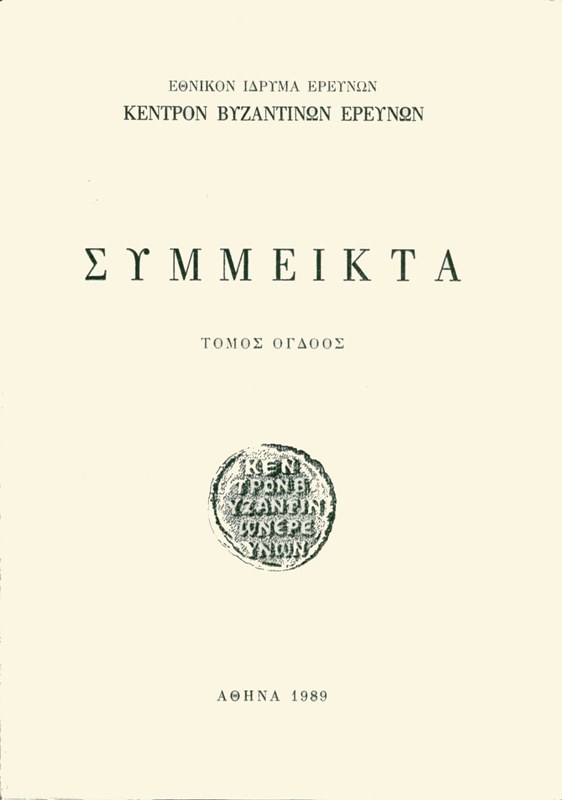Τὰ οἰκονομικὰ τῶν ἐπισκόπων στίς πρῶτες δεκαετίες τοῦ 16ου αἰώνα καὶ ἡ περίπτωση τοῦ Γενναδίου Σερρῶν
Περίληψη
Criton Chryssochoidis
The Financial Situation of Bishops in the First Decades of the 16th Century and the Case of Gennadius of Serres
In the first part of this study evidence about the personality and the activities of Gennadius, metropolitan of Serres, is examined. An important feature of his long rule (1509-1540) is the donations he granted to monasteries, namely the Great Lavra in Mount Athos, as well as to the metropolis of Serres. As far as the Great Lavra is concerned, Gennadius financed the restoration and the wall paintings of the trapeza. He also offered precious objects, manuscripts and bought adelphata. Gennadius made also generous donations to the metropolis of Serres, to the adjacent monastery of Prodromos and the monastery of Kossinitza.
The 16th century is generally considered as a period of financial difficulty for the Christian population of the Ottoman Empire. The presence of a wealthy bishop is examined in the second part of the present study within this framework. In particular, we focus on the development of the financial situation of a metropolitan as it emerges through the synodic acts of election and ordination of the prelates and of berats, with which the election was acknowledged by the Ottoman authorities and the actual appointment took place.
In the Greek documents of the second half of the 15th century references to the financial state of hierarchs are vague and general. On the contrary, in the 16th century, and especially after the synodic act of 1497, which among other things regulated issues regarding the income of bishops and the way of its collection, we encounter more detailed information that enable us to acquire a clearer picture. Ottoman berats present a similar picture.
Combining this evidence with that deriving from other sources we may draw conclusions about the institutionalised income of metropolitans in the first decades of the 16th century: kanonikon, marriage rates, income from ecclesiastical fairs (panegyris), sources of holy water (hagiasma), zeteia, heritage of priests and monks, other usual sources (ta synethe) of income (emvatikion, exagoreutikion), income from properties owned by the metropolis as well as income from subordinate bishops. Finally, we conclude that this income together with the stable state of the currency, especially during the first half of the 16th century, and the political stability of the Ottoman state contributed to the development of bishops' finances, to the accumulation of wealth and of a surplus, that could thus be used for donations, an activity widespread among the bishops at the 16th century.
Λεπτομέρειες άρθρου
- Πώς να δημιουργήσετε Αναφορές
-
ΧΡΥΣΟΧΟΪΔΗΣ Κ. (1998). Τὰ οἰκονομικὰ τῶν ἐπισκόπων στίς πρῶτες δεκαετίες τοῦ 16ου αἰώνα καὶ ἡ περίπτωση τοῦ Γενναδίου Σερρῶν. Βυζαντινά Σύμμεικτα, 12, 271–317. https://doi.org/10.12681/byzsym.856
- Τεύχος
- ΣΥΜΜΕΙΚΤΑ 12
- Ενότητα
- Άρθρα

Αυτή η εργασία είναι αδειοδοτημένη υπό το CC Αναφορά Δημιουργού – Μη Εμπορική Χρήση – Παρόμοια Διανομή 4.0.
Οι συγγραφείς των άρθρων που δημοσιεύονται στα ΒΥΖΑΝΤΙΝΑ ΣΥΜΜΕΙΚΤΑ διατηρούν τα δικαιώματα πνευματικής ιδιοκτησίας επί των άρθρων τους, δίνοντας στο περιοδικό το δικαίωμα της πρώτης δημοσίευσης. Άρθρα που δημοσιεύονται στα ΒΥΖΑΝΤΙΝΑ ΣΥΜΜΕΙΚΤΑ μπορούν να χρησιμοποιούνται ελεύθερα, χωρίς δικαίωμα τροποποίησης (δημιουργία παράγωγου έργου) με αναφορά στο συγγραφέα και στην πρώτη δημοσίευση για μη κερδοσκοπικούς σκοπούς(άδεια Creative Commons 4.0). To Εθνικό Ίδρυμα Ερευνών διατηρεί το δικαίωμα να δημοσιεύει, να αναπαραγάγει, να παρουσιάζει στο κοινό, να διανέμει και χρησιμοποιεί άρθρα που δημοσιεύονται στα ΒΥΖΑΝΤΙΝΑ ΣΥΜΜΕΙΚΤΑ σε οποιοδήποτε μέσο και μορφή είτε μεμονωμένα είτε ως μέρη συλλογικών έργων, για όλο το χρόνο διάρκειας προστασίας της πνευματικής ιδιοκτησίας και για όλες τις χώρες του κόσμου. Αυτό περιλαμβάνει ενδεικτικά και όχι αποκλειστικά, το δικαίωμα δημοσίευσης των άρθρων σε τεύχη του περιοδικού ΒΥΖΑΝΤΙΝΑ ΣΥΜΜΕΙΚΤΑ, αναπαραγωγής και διανομής μεμονωμένων αντιγράφων των άρθρων, αναπαραγωγής ολόκληρων των άρθρων σε άλλη έκδοση του ΕΙΕ, και αναπαραγωγής και διανομής των άρθρων ή περίληψης αυτών με χρήση πληροφορικού συστήματος αποθετηρίου.







